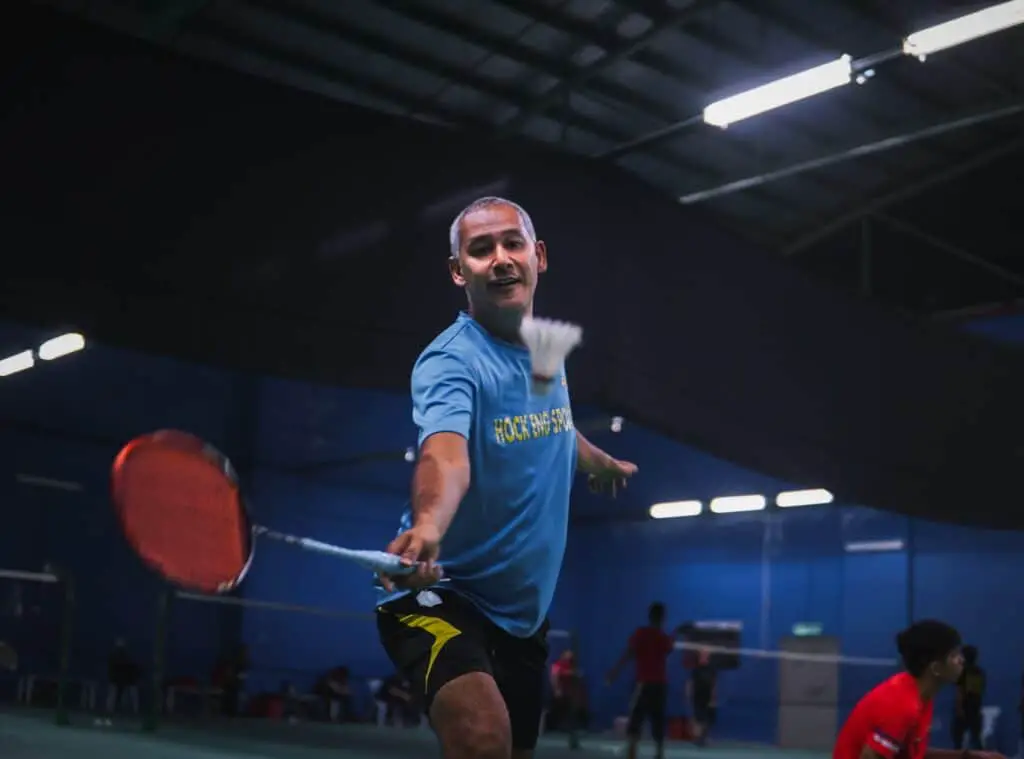When watching the backhand serve on television, it appears to be smooth, easy, and thoughtless.
Few people realize how many hours and sweat it takes to achieve that flawless serve with a racket. The majority of players have trouble getting the shuttle consistently over the net! The service is both important and difficult, and it has the potential to be a game-changing strategy.
The backhand serve is as important as it is difficult; most world-class players agree that a single-serve can decide the outcome of a rally!
Let’s break it down into steps so you can master the badminton backhand serve!
1.Use a backhand grip to begin.
Some pointers to keep in mind:
- Grip your racket loosely but comfortably.
- Should you need more control, you can grip slightly above the hilt.
- Don’t worry about getting the grip just right; you’ll be able to adjust it as we go.
2. Get a good shuttle grip
Hold the shuttle feather between your thumb and forefinger (or middle finger if necessary) and tilt the shuttle head towards you, feathers facing the net.

The angle at which the shuttle is tilted will have a significant impact on the trajectory of the serve; make appropriate adjustments.
3. Take your place
Because the badminton backhand serve is used in both doubles and singles, we’ll talk about where to stand later.

To prepare for the badminton backhand serve, position yourself with your racket foot forward and your shuttle and racket bearing arms forward, as shown in the diagrams above.
4. Take a Shot
There are two variations of the badminton backhand serve, which can be used in both doubles and singles.
- Serve with a Flick
- Low-Cost Serving
Depending on your strategy and whether you’re playing singles or doubles/mixed doubles, the red crosses will indicate your position on the court.
The low backhand serve’s target would be anywhere within the yellow box.
The flick serve’s target would be anywhere inside the blue box.
5. Fire Away
The badminton backhand serve begins with the weight on the back foot, shifting to the front foot as they serve progress. This creates momentum and a more consistent flow, resulting in a higher-quality backhand serve.
As shown in the gif above, the wrist should be pulled back and flicked gently to propel the shuttle forward.
The shuttle should be placed at a comfortable distance from the body and arm so that enough momentum can be generated for effective badminton serve (especially in a flick serve). Feel free to experiment with different distances until you find one that works for you!
The low serve should fly just above the net and land directly behind the service line. The shuttle would be raised and tilted slightly upwards for the flick serve. More effort should be put into the technique in order for the shuttle to reach its intended destination.
Although the high serve isn’t really applicable to the backhand serve, this diagram depicts how the trajectories should be. While the flick serve will eventually land at the back of the court, it should travel quickly and without much height. The low serve should fly just above the net and land directly behind the service line.
Types of backhand serve
1.Backend high serve
Even though the reasons for using the backhand high serve in singles and doubles are quite different, the backhand high serve is used in both.
The backhand high serve is used as a surprise shot in doubles. Because the main goal in doubles is to take the initiative, serving high should never be used as a standard resource because it will almost always result in a loss of initiative. It can, however, be a very effective shot when used sparingly, especially if your opponent is getting very close to the front line to receive.

In singles, the backhand high serve is more frequently used because maintaining the initiative is less important. Most professional players, on the other hand, use it far less than the backhand low serve.
2.Backhand low serve
The backhand low serve, which was previously only used for doubles, is now the default serve for both doubles and singles, especially in men’s singles.
The reason for this is very simple in doubles. This service is the most effective in terms of attempting to keep the point’s initiative, which is critical to a doubles match’s success. In doubles, serving high as a regular resource is badminton suicide. Because serving low is the best option, the backhand serve becomes the default option because it is the simplest and most reliable.
It has become a much more popular option among singles in recent years. Serving high in singles has become riskier as players improve, as it gives the opponent a lot of time to prepare their first shot of the rally. As a result, many of the top players now favour the backhand low serve as their primary serve.
Conclusion
The backhand badminton serve technique is a very complex technique, and there are numerous tips to help you optimise it and use it effectively in a badminton match.
Of course, mastering the badminton serve takes a lot of practise, but it’s not difficult!